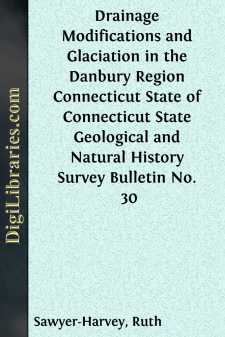Categories
- Antiques & Collectibles 13
- Architecture 36
- Art 48
- Bibles 22
- Biography & Autobiography 813
- Body, Mind & Spirit 142
- Business & Economics 28
- Children's Books 17
- Children's Fiction 14
- Computers 4
- Cooking 94
- Crafts & Hobbies 4
- Drama 346
- Education 46
- Family & Relationships 57
- Fiction 11829
- Games 19
- Gardening 17
- Health & Fitness 34
- History 1377
- House & Home 1
- Humor 147
- Juvenile Fiction 1873
- Juvenile Nonfiction 202
- Language Arts & Disciplines 88
- Law 16
- Literary Collections 686
- Literary Criticism 179
- Mathematics 13
- Medical 41
- Music 40
- Nature 179
- Non-Classifiable 1768
- Performing Arts 7
- Periodicals 1453
- Philosophy 64
- Photography 2
- Poetry 896
- Political Science 203
- Psychology 42
- Reference 154
- Religion 513
- Science 126
- Self-Help 84
- Social Science 81
- Sports & Recreation 34
- Study Aids 3
- Technology & Engineering 59
- Transportation 23
- Travel 463
- True Crime 29
Drainage Modifications and Glaciation in the Danbury Region Connecticut State of Connecticut State Geological and Natural History Survey Bulletin No. 30
Description:
Excerpt
The region discussed in this bulletin is situated in western Connecticut and is approximately 8 miles wide and 18 miles long in a north-south direction, as shown on
.Throughout, the rocks are crystalline and include gneiss, schist, and marble--the metamorphosed equivalents of a large variety of ancient sedimentary and igneous rocks.For the purposes of this report, the geologic history may be said to begin with the regional uplift which marked the close of the Mesozoic. By that time the mountains formed by Triassic and Jurassic folding and faulting had been worn down to a peneplain, now much dissected but still recognizable in the accordant level of the mountain tops.
Erosion during Cretaceous time resulted in the construction of a piedmont plain extending from an undetermined line 30 to 55 miles north of the present Connecticut shore to a point south of Long Island. This plain is thought to have been built up of unconsolidated sands, clays, and gravels, the débris of the Jurassic mountains. Inland the material consisted of river-made or land deposits; outwardly it merged into coastal plain deposits. When the plain was uplifted, these loose gravels were swept away. In New York, Pennsylvania, and New Jersey, however, portions of the Cretaceous deposits are still to be found. Such deposits are present, also, on the north shore of Long Island, and a well drilled at Barren Island on the south shore revealed not less than 500 feet of Cretaceous strata. The existence of such thick deposits within 30 miles of the Connecticut shore and certain peculiarities in the drainage have led to the inference that the Cretaceous cover extended over the southern part of Connecticut.
A general uplift of the region brought this period of deposition to a close. As the peneplain, probably with a mantle of Cretaceous deposits, was raised to its present elevation, the larger streams kept pace with the uplift by incising their valleys. The position of the smaller streams, however, was greatly modified in the development of the new drainage system stimulated by the uplift. The modern drainage system may be assumed to have been at first consequent, that is, dependent for its direction on the slope of the uplifted plain, but it was not long before the effect of geologic structure began to make itself felt. In the time when all the region was near baselevel, the harder rocks had no advantage over the softer ones, and streams wandered where they pleased. But after uplift, the streams began to cut into the plain, and those flowing over limestone or schist deepened, then widened their valleys much faster than could the streams which flowed over the resistant granite and gneiss. By a system of stream piracy and shifting, similar to that which has taken place throughout the Newer Appalachians, the smaller streams in time became well adjusted to the structure. They are of the class called subsequents; on the other hand, the Housatonic, which dates at least from the beginning of the uplift if not from the earlier period of peneplanation, is an antecedent stream.
The complex rock surface of western Connecticut had reached a stage of mature dissection when the region was invaded by glaciers. The ice sheet scraped off and redistributed the mantle of decayed rock which covered the surface and in places gouged out the bedrock....


